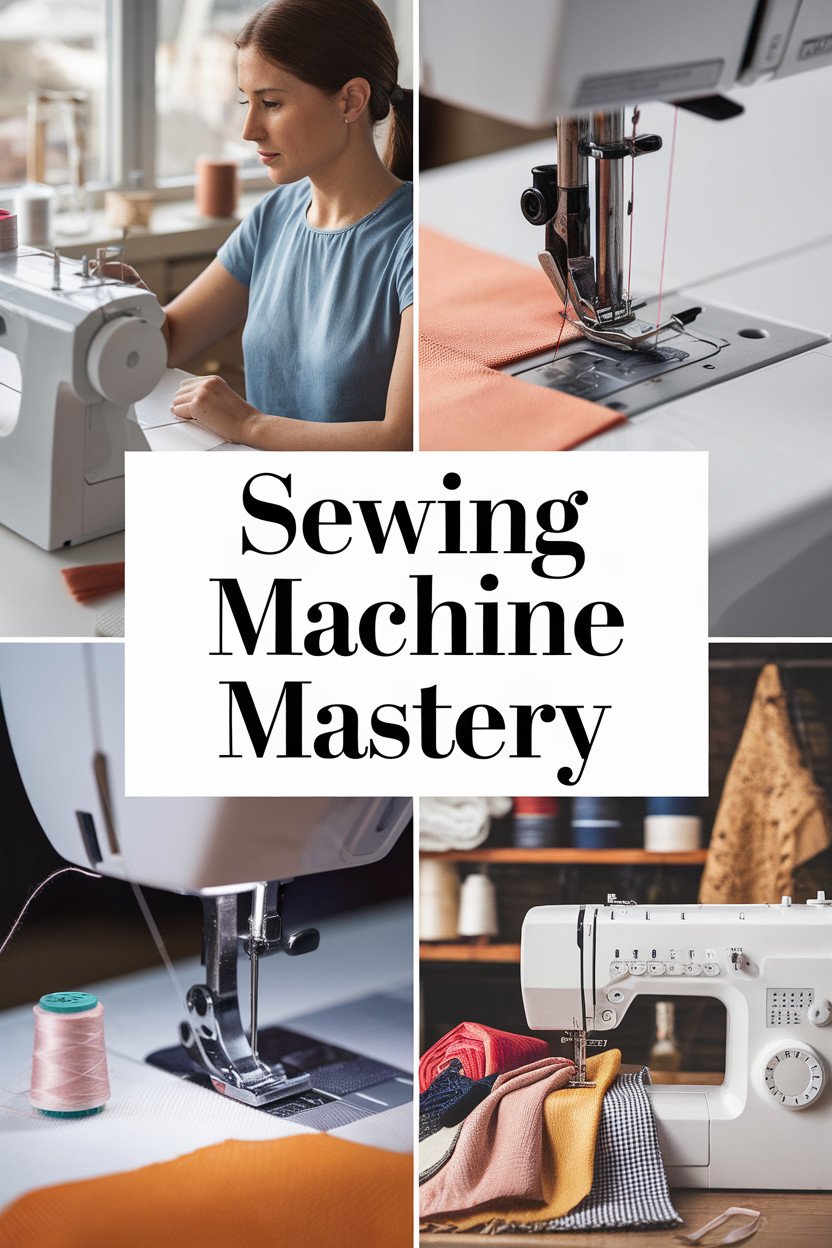Welcome to the world of Sewing Machine Mastery! Whether you’re a beginner or an experienced sewist, this comprehensive guide is designed to take you on a journey from sewing basics to advanced skills. With step-by-step instructions, tips, and tricks, we’ll help you unlock the full potential of your sewing machine and take your creativity to new heights. Get ready to experience seamless stitching projects and become a true Sewing Wizard!
Understanding the basics of your sewing machine is essential before diving into sewing projects. That’s why we’ll cover everything you need to know about the different parts and functions, how to thread your machine, and the various stitches it can create. Plus, we’ll provide detailed tutorials that will make you feel confident in using your machine.
From straight stitching to zigzag stitches, this guide will cover a variety of essential sewing machine techniques that will enhance your sewing skills. We’ll guide you through each technique with clear instructions and helpful tips, so you’ll be able to adjust tension, sew curves, and create buttonholes with ease.
Ready to take your sewing to the next level? Our guide will walk you through advanced sewing machine skills that will elevate your craftsmanship. Discover techniques for decorative stitching, quilting, appliqué, and more. With our step-by-step tutorials, you’ll be able to expand your repertoire and achieve professional-looking results.
Key Takeaways:
- Become a Sewing Wizard with our comprehensive guide
- Understand the basics of your sewing machine with our tutorials
- Master essential sewing machine techniques, including tension adjustment and buttonhole creation
- Elevate your sewing skills with advanced techniques like quilting and appliqué
- Unlock the full potential of your sewing machine and take your creativity to new heights
Understanding Your Sewing Machine
Before you can start stitching, it’s important to familiarize yourself with the basics of your sewing machine. Here are some essential sewing machine basics to get you started:
- Identify the different parts of your sewing machine, such as the needle, presser foot, and bobbin.
- Refer to your machine’s manual for specific instructions on how to thread your machine.
- Familiarize yourself with the various stitches your machine can create, such as straight stitch, zigzag stitch, and buttonhole stitch.
Now that you have a general understanding of your machine, it’s time to start practicing! Here are some sewing machine tutorials to help you get comfortable with your machine:
- Practice sewing straight lines on a piece of scrap fabric to get a feel for the machine.
- Experiment with different stitch lengths and widths to see how they affect your projects.
- Practice sewing on different types of fabric to get a sense of how the machine handles each one.
Remember, mastering your sewing machine takes time and practice. Don’t be afraid to make mistakes and try new things!
Threading your sewing machine can seem daunting at first, but with a little practice, it will become second nature. Here is a basic guide to threading your machine:
- Begin with the thread spool on the top of your machine. Place the thread through the thread guide and pull it down.
- Take the thread and loop it around the tension disc, then pull it back up.
- Thread the take-up lever and pull the thread through the final thread guide. Continue threading until the thread reaches the needle.
- Thread the needle and pull the thread through the presser foot.
- Hold onto the thread and turn the wheel to bring the needle down and up again to catch the bobbin thread.
- Pull the bobbin thread up and you’re ready to start sewing!
With these tips and techniques, you’ll be well on your way to mastering your sewing machine in no time. Happy stitching!
Essential Sewing Machine Techniques
Now that you’re familiar with your sewing machine, it’s time to master essential sewing machine techniques. Here are some tips and tricks to elevate your sewing skills:
- Straight Stitch: The most basic sewing machine technique, used for sewing seams and hems. Adjust the stitch length and tension to achieve the desired result.
- Zigzag Stitch: A versatile stitch used for finishing edges, appliqué, and decorative purposes. Experiment with the stitch width and length for different effects.
- Adjusting Tension: The tension regulates the tightness of the stitch. Adjust it based on the type of fabric and thread you’re using.
- Corners and Curves: For corners, stop with the needle down, lift the presser foot, pivot the fabric, and continue sewing. For curves, sew slowly and use your hands to guide the fabric.
Remember to always practice these techniques on scrap fabric before starting a project to ensure the best results!
Mastering Buttonholes
Buttonholes are a functional and crucial component of many sewing projects. Here’s how to create perfect buttonholes:
- Marking the Placement: Use tailor’s chalk to mark the buttonhole placement. Measure the button diameter and add 1/8 inch for the buttonhole length.
- Selecting the Buttonhole Setting: Check your machine’s manual for the specific buttonhole setting. Some machines have automatic buttonhole settings, while others require manual adjustment.
- Practice: Practice on scrap fabric to ensure the buttonhole size and length are correct before beginning on your project.

With these techniques and tips, you’re well on your way to becoming a sewing machine mastery! Remember to always practice, experiment, and have fun with your sewing projects.
Building Advanced Sewing Machine Skills
Congratulations! Now that you’ve mastered the basics, let’s dive into some advanced sewing machine skills. These techniques will take your sewing game to the next level, making your projects stand out with professional quality.
Decorative Stitching
If you’re tired of basic straight stitches, it’s time to experiment with decorative stitching. Your sewing machine likely has a range of decorative stitches, from scallops to stars, and everything in between. Try these tips to get started:
- Practice on scrap fabric first to get comfortable with the stitch
- Adjust your stitch length and width to find the perfect setting for your design
- Use contrasting thread colors to make your stitching pop
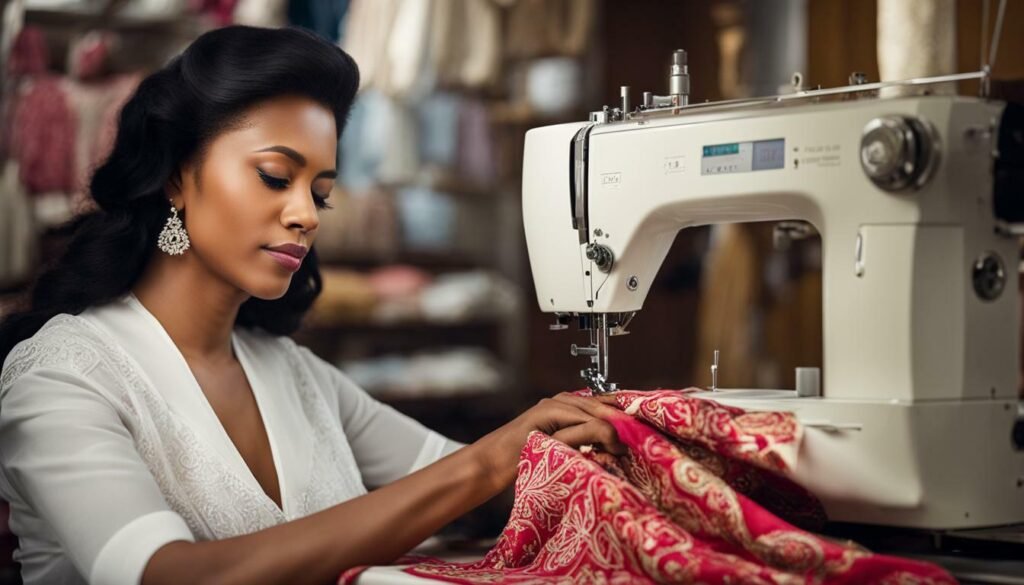
Quilting is a sewing technique that involves stitching together layers of fabric and batting to create a thick, cozy blanket. It can also be used for other projects like table runners or wall hangings. Try these tips for successful quilting:
- Invest in a walking foot, which helps move all the layers of fabric evenly through the machine
- Match your thread color to your fabric for a cohesive look
- Practice your stitching on small projects before diving into a full-sized quilt
Appliqué
Appliqué is a sewing technique that involves adding decorative fabric shapes to a larger piece of fabric. It’s a fun way to personalize your projects and add unique touches. Try these tips for successful appliqué:
- Choose fabrics that complement each other for a cohesive look
- Use fusible web to secure your appliqué in place before stitching
- Try different stitching methods, like zigzag or satin stitch, to add interest
With these advanced sewing machine skills, you’ll be able to create one-of-a-kind projects that showcase your creativity. Keep practicing and experimenting to continue improving your sewing skills!
Troubleshooting Common Sewing Machine Issues
Despite its usefulness, sewing machines can develop issues from time to time. Here are some common problems that you might encounter and their solutions.
Jammed Thread
A jammed thread is a common problem that can occur when sewing. Here’s how to resolve it:
- Turn off the machine and unplug it.
- Remove the bobbin and check for any jammed threads.
- Remove any thread or debris that you find.
- Rethread the machine and test it on a scrap of fabric.
This should help to clear the jam and get your machine working again.
Skipped Stitches
Skipped stitches are another common problem that sewers encounter. Here’s what to do if you’re experiencing them:
- Check the needle for any damage or wear. If it’s bent or dull, replace it.
- Ensure that the needle is inserted correctly and facing the right direction.
- Check the thread tension. If it’s too tight or too loose, adjust it accordingly.
- Ensure that the bobbin is inserted correctly and that the thread is wound evenly.
- Try a different type of thread or fabric.
By taking these steps, you should be able to eliminate skipped stitches and achieve smooth, even stitches.
Breaking Needles
Breaking needles may occur when sewing. Here are some reasons why it might be happening and how to address each:
- The needle may be hitting a part of the machine, such as the presser foot or throat plate. Adjust the needle position and ensure that all parts are in the correct place.
- The needle may be the wrong size for the fabric you’re using. Choose the correct size needle.
- The needle may be bent or dull. Replace it.
- Ensure that you’re using the correct type of needle for the fabric you’re sewing.
Breaking needles can be frustrating, but taking these steps can help eliminate the problem and keep your machine running smoothly.

Taking care of your sewing machine and troubleshooting common issues will help you sew with ease!
Proper Maintenance for Your Sewing Machine
If you want your sewing machine to function at its best, regular maintenance is key. Follow these tips to keep your machine in optimal condition:
- Clean your machine after each use. Use a soft cloth to remove any dust or lint that may have accumulated on the machine.
- Oil your machine regularly. Oiling your machine will help it run smoothly and prevent wear and tear on the moving parts. Check your machine’s manual for instructions on where and how to oil it.
- Replace your needle often. Using an old or dull needle can cause skipped stitches or damage to your fabric and machine. Replace your needle after every project or after every 8 hours of use.
- Check your machine’s tension. If your stitches look uneven or your thread keeps breaking, it may be due to incorrect tension. Consult your machine’s manual for instructions on how to adjust the tension.
- Make sure your machine is properly threaded. Incorrect threading can cause issues with your stitches and damage your machine. Consult your machine’s manual for instructions on how to thread it properly.
By taking these simple steps, you can ensure that your sewing machine stays in top condition and produces quality stitches every time you use it.
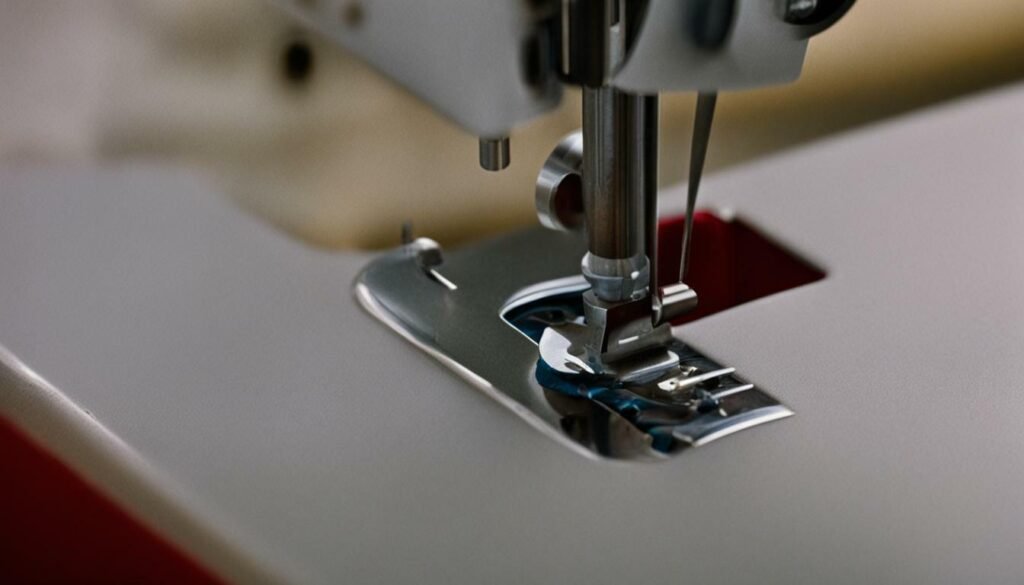
Even with regular maintenance, your sewing machine may still require professional servicing from time to time. Here are some signs that it may be time to take your machine in for a tune-up:
- Your machine is making unusual noises or vibrations.
- Your stitches are consistently uneven or skipped.
- Your machine is jamming frequently.
- Your machine is skipping stitches or breaking your thread.
If you notice any of these issues, it’s best to take your machine to a professional for servicing. They can diagnose the problem and make any necessary repairs to keep your machine running smoothly.
Tips for Storing Your Sewing Machine
Proper storage of your sewing machine is important to maintain its longevity. Here are some tips for storing your machine:
- Store your machine in a cool, dry place away from direct sunlight and humidity.
- Cover your machine with a dust cover to protect it from dust and other particles.
- Remove the needle and foot pedal before storing your machine.
- Unplug your machine when it’s not in use to prevent any electrical issues.
By taking these precautions, you can ensure that your sewing machine stays in good condition for years to come.
Choosing the Right Accessories for Your Sewing Machine
When it comes to sewing, having the right accessories can make all the difference. Here are some must-have accessories for your sewing machine:
- Presser Feet: Different presser feet can help you attach zippers, create buttonholes, and more. Make sure you have the right foot for the job.
- Needles: Choose the correct needle for your fabric to prevent damage and create beautiful stitches.
- Bobbins: Always keep extra bobbins on hand to avoid running out of thread mid-project.
- Seam Ripper: Mistakes happen, but a seam ripper can help you correct them quickly and easily.
- Thread Scissors: Keep a pair of sharp scissors handy for trimming thread ends and cutting fabric.
Additional accessories can make sewing even easier and more enjoyable:
- Walking Foot: This foot helps feed thick fabrics through your machine, ensuring consistent stitches.
- Embroidery Foot: Add decorative stitches and embellishments to your projects with an embroidery foot.
- Rotary Cutter and Mat: For precise cuts and smooth edges, invest in a quality rotary cutter and cutting mat.
- Quilting Ruler: If you’re into quilting, a quilting ruler can help you measure and cut fabric quickly and accurately.
Before purchasing accessories, make sure they’re compatible with your specific sewing machine model. And remember, while accessories can enhance your sewing experience, they’re not necessary to create beautiful projects.
Image
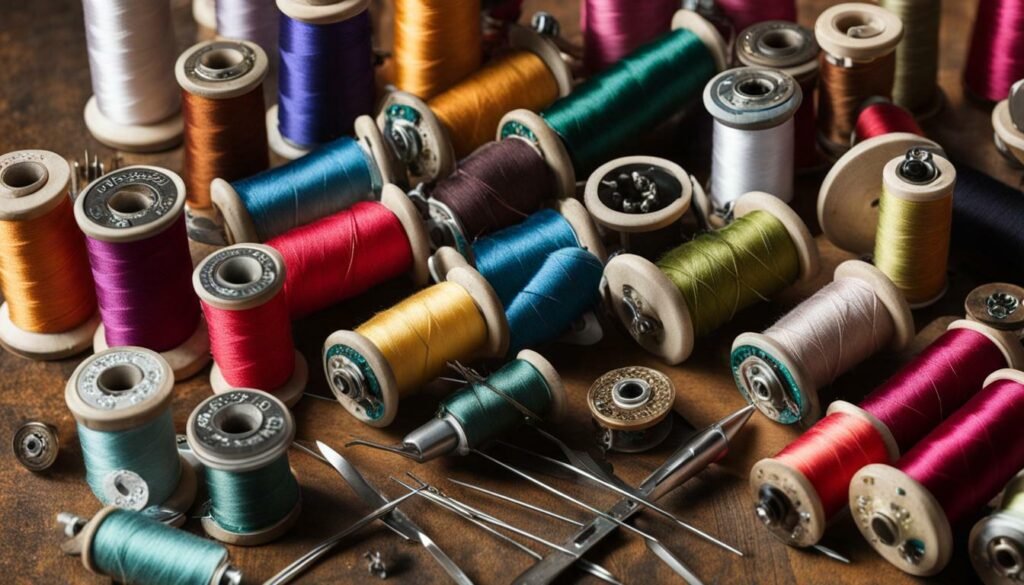
By investing in the right accessories, you can take your sewing projects to the next level and achieve impressive results.
Choosing the Right Accessories for Your Sewing Machine
Just like any other tool, your sewing machine can benefit from a few accessories to make certain tasks easier. Here are some essential accessories to consider:
- Presser Feet: Different presser feet can help you handle different fabrics and sewing techniques. Some popular presser feet include a zipper foot, buttonhole foot, and walking foot.
- Needles: Your sewing machine likely came with a universal needle, but there are needles specifically designed for different fabric types, like denim or stretch fabrics.
- Bobbins: Always have extra bobbins on hand for when you need to change your thread color or if one runs out.

To take your sewing to the next level, consider these optional accessories:
- Specialty Feet: Depending on your sewing interests, you might consider investing in specialty feet, such as a piping foot or a ruffler foot.
- Attachments: Some sewing machines have the ability to attach extra features, like a quilting table.
Before investing in any accessories, check your sewing machine’s manual to ensure compatibility. Some brands might have proprietary accessories, while others have more universal options.
Embroidery and Embellishment Techniques
Unleash your creativity with embroidery and embellishment techniques! Adding unique design elements to your sewing projects is a great way to add personalization and flair. With your sewing machine, you can create beautiful embroidery designs, monograms, and decorative accents on fabric.
One of the most popular embroidery techniques is free-motion embroidery, where you use your machine to “draw” on the fabric with thread. This technique allows for intricate designs and high detail. With practice, you can create stunning designs that showcase your artistic abilities.
- Use an embroidery foot to ensure even stitching and easy movement of the fabric
- Draw your design onto the fabric using a removable fabric marker or chalk
- Select the appropriate needle and thread for your project
- Lower your feed dogs and use your hands to move the fabric in the desired direction
- Practice on a scrap piece of fabric before starting on your project to get the hang of the technique
Another embellishment technique is appliqué, where you add a decorative fabric layer on top of your base fabric. This technique can be used for adding designs or even repairing small holes or tears in fabric.
- Select a fabric that complements your base fabric
- Cut out your desired shape or design and pin it to the base fabric
- Use a zigzag stitch or satin stitch to sew the edges of the fabric to the base fabric
- Trim any excess fabric to achieve a clean finish
Adding beads, sequins, and other small embellishments can also elevate the look of your sewing projects. Use a narrow zigzag stitch to attach the embellishments to your fabric.

With these embroidery and embellishment techniques, you can transform your sewing projects into unique works of art. Experiment with different designs and materials to find your personal style and take your sewing machine skills to the next level!
Exploring Specialty Sewing Machine Features
Your sewing machine comes with a range of specialty features that can help you unleash your creativity. Here are some of the features that you should explore:
- Automatic buttonholes: Your machine can create buttonholes with ease. All you have to do is select the size and style of the buttonhole, and the machine will do the rest.
- Decorative stitches: Your machine can create a variety of decorative stitch patterns. Use them to add interest to your projects, from quilts to clothing and home decor.
- Stretch stitches: If you’re sewing knit fabrics, stretch stitches can help you create durable and flexible seams.
- Blind hemming: This feature allows you to create nearly invisible hems, perfect for dress pants or skirts.
- Adjustable foot pressure: This feature allows you to adjust the pressure of your machine’s presser foot to accommodate different fabrics.
Don’t be afraid to experiment with these features! Play around with the settings and test them out on different fabrics to see the effects they create.
Using Automatic Buttonhole Feature
Automatic buttonholes can save you time and frustration. Here’s how to use them:
- Attach the buttonhole foot to your machine.
- Mark the placement of your buttonhole on your fabric.
- Place your fabric under your machine’s needle, making sure the needle is lined up with the starting point of the buttonhole.
- Select the buttonhole size and style on your machine.
- Start the machine and let it run until it completes the buttonhole.
- Cut open the buttonhole using a fabric cutter or scissors.
With a little practice, you’ll be creating flawless buttonholes in no time!
Exploring Decorative Stitches
Decorative stitches can add a unique touch to your projects. Here’s how to use them:
- Select the decorative stitch you want to use on your machine.
- Adjust the stitch length and width as desired.
- Practice the stitch on a scrap piece of fabric to ensure it looks the way you want it to.
- Sew the decorative stitch on your project, either as a standalone design or to embellish a seam or edge.
With so many decorative stitches to choose from, the possibilities are endless!

Adjustable foot pressure allows you to sew through different fabrics with ease. Here’s how to use it:
- Select the fabric you want to sew on.
- Adjust the foot pressure according to the thickness of the fabric.
- Practice sewing on a scrap piece of fabric to ensure the stitch tension is correct.
- Sew your project with confidence, knowing that your machine is set up correctly for the fabric you’re using.
Experiment with different foot pressures to see how they affect your sewing projects.
Sewing Machine Safety Tips: Protect Yourself and Your Machine
As you delve into the world of sewing machine mastery, safety is essential to keep in mind. By taking certain precautions, you can prevent accidents and ensure a safe and enjoyable sewing experience. Here are some sewing machine safety tips to keep in mind:
- Always unplug your sewing machine before cleaning, oiling, or making any adjustments.
- Never place your fingers or any other objects near the needle or other moving parts while the machine is in operation.
- Be mindful of loose clothing or jewelry that could get caught in the machine while sewing.
- Use the correct type and size of needle for the fabric you are sewing on, and make sure the needle is inserted correctly and securely.
- Keep your sewing area clean and organized to prevent tripping hazards or accidental spills on your machine.
- Always use a sewing machine cover when the machine is not in use to protect it from dust and damage.
- If you notice any unusual noises, vibrations, or other issues with your machine, stop using it immediately and seek professional repair.
By following these safety tips, you can protect both yourself and your sewing machine. Remember, safety should always come first!
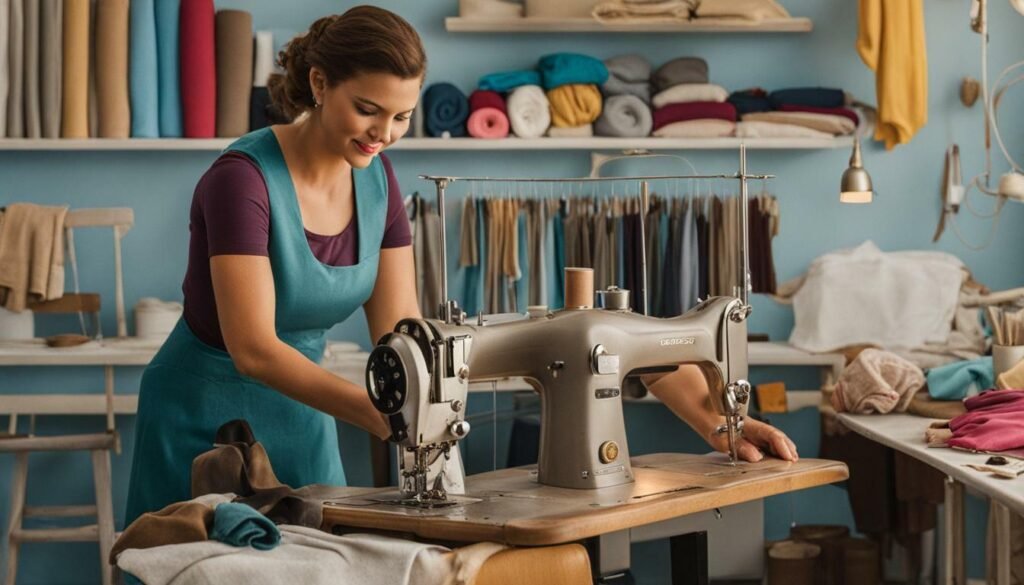
In addition to these general tips, it’s important to review the specific safety guidelines outlined in your sewing machine manual. Take the time to read through the manual thoroughly and follow the manufacturer’s recommended safety precautions. Here are some more safety tips to keep in mind:
- Always use the correct power cord and electrical outlet for your machine to prevent electrical hazards.
- Never use a damaged or frayed power cord or plug, and never attempt to repair a damaged cord yourself.
- Keep your machine out of reach of children and pets.
- Never operate your machine with wet hands or when standing on a wet surface to prevent electrical shocks.
- Always use the presser foot when sewing to ensure proper stitching and prevent injury from the needle.
By following these additional safety guidelines, you can help ensure a safe and stress-free sewing experience. Remember, sewing machine mastery starts with safety!
Sewing Machine Mastery for Beginners
If you’re new to sewing, it can be overwhelming to start using your sewing machine. But don’t worry, we’ve got you covered with these sewing machine tips and techniques for beginners.
Here are some helpful tips to get you started:
- Read your sewing machine manual thoroughly, familiarize yourself with the machine’s parts and functions.
- Practice threading your machine until it becomes second nature.
- Start with simple projects like a pillowcase or a tote bag to build your confidence.
- Don’t be afraid to make mistakes. It’s part of the learning process.
Once you feel comfortable with the basics, try these sewing machine techniques for beginners:
- Straight stitching: Practice sewing straight lines to get comfortable with the machine’s speed and pressure settings.
- Zigzag stitching: Learn how to sew zigzag stitches for finishing seams and decorative accents.
- Tension adjustment: Experiment with different thread tensions to achieve balanced stitches.
- Buttonhole making: Learn how to sew buttonholes for closures on garments and accessories.
Remember, sewing machine mastery takes time and practice. Don’t get discouraged if your first projects don’t turn out perfectly. Keep practicing and soon you’ll be on your way to creating beautiful handmade creations.
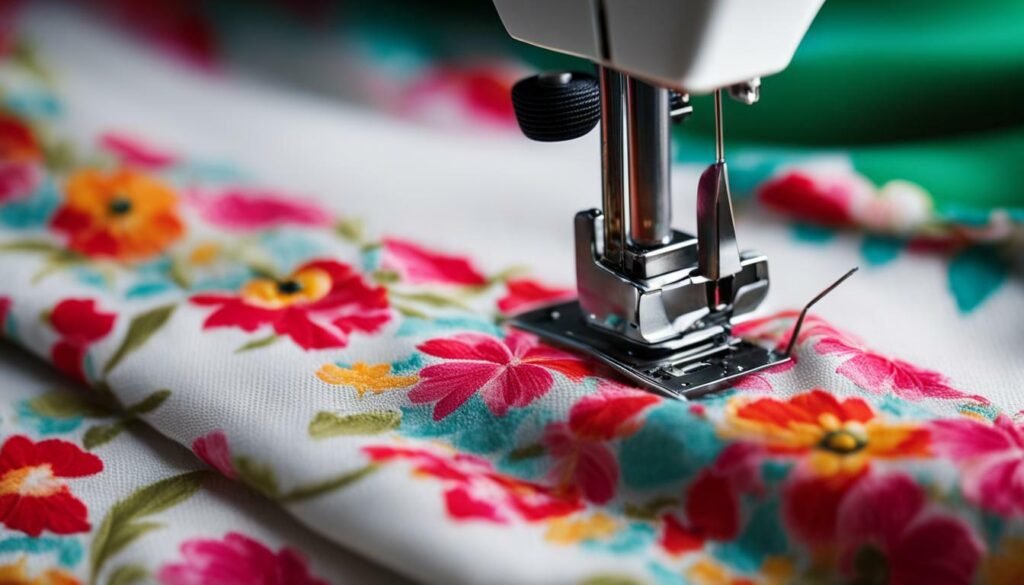
One final tip: Join a sewing machine community or take a class to learn from fellow sewists. You’ll find support, motivation, and inspiration to continue your sewing machine mastery journey. Happy stitching!
Inspiring Sewing Machine Projects
Now that you’ve mastered the basics of your sewing machine, it’s time to put your skills to the test with some inspiring sewing projects. From simple accessories to intricate quilts, there are endless possibilities for what you can create with your sewing machine. Here are a few project ideas to get you started:
- Pillowcases: Create custom pillowcases to match your home decor. Choose your favorite fabrics and use decorative stitching to add some flair.
- Tote bags: Make stylish and functional tote bags for everyday use. Experiment with different fabrics and add pockets, zippers, and other embellishments as desired.
- Table runners: Dress up your dining table with a beautiful table runner. Use contrasting fabrics and decorative stitches to add some visual interest.
- Aprons: Stay clean while cooking with a handmade apron. Choose a fun fabric print and add pockets for convenience.
- Quilts: Create a cozy and personalized quilt to snuggle up with. Experiment with different quilt block patterns and fabrics to make a truly unique creation.

Don’t be afraid to get creative and try new things with your sewing machine. The possibilities are endless, and the more you practice, the more confident you’ll become in your skills. Remember to have fun and enjoy the process!
Connecting with Sewing Machine Mastery Community
Now that you’ve mastered your sewing machine, it’s time to connect with other sewing enthusiasts! Joining a sewing machine community can provide you with inspiration, advice, and support as you continue to grow your skills. Here are some resources to help you connect:
- Sewing Machine Addicts – Join this Facebook group to connect with other sewing machine enthusiasts and share your projects.
- r/Sewing – This subreddit is a great place to ask questions, get advice, and share your latest sewing machine creations.
- Sewing Machines Plus – This website offers a variety of resources, including forums, a blog, and an online community, to connect with other sewing enthusiasts.
By connecting with other sewists, you’ll be able to expand your knowledge and find new inspiration for your sewing projects. Plus, it’s always fun to share your creations with others who appreciate the art of sewing!

Remember, the sewing machine community is a supportive and welcoming space. Don’t be afraid to ask questions or share your work – everyone started somewhere, and we all have something to learn from each other.
Continuing Your Sewing Machine Mastery Journey
Congratulations on completing this comprehensive guide to sewing machine mastery! But the learning doesn’t have to stop here. Keep honing your skills and elevating your projects with these tips:
1. Experiment with new techniques
Challenge yourself by trying out new sewing machine techniques. Browse online tutorials, take a class, or simply explore your machine’s features to discover what it can do. Don’t be afraid to make mistakes – they’re all part of the learning process!
2. Expand your project repertoire
Branch out from your usual sewing projects and try something new. Whether it’s sewing a garment, creating home decor, or making accessories, diversifying your projects will help you learn new skills and keep your creativity flowing.
- Join a sewing club to get inspired by other sewists’ projects and expertise
- Check out Pinterest and Instagram for ideas and tutorials
3. Master different fabrics
Continue to experiment with sewing on different types of fabrics to expand your skillset. Use our tips for mastering delicate fabrics, knit fabrics, and heavyweight materials as a guide.
- Experiment with different fabrics that you haven’t sewed with before
- Consider taking a class or workshop dedicated to sewing on a specific fabric type
4. Maintain your sewing machine
Regular maintenance is key to keeping your sewing machine running smoothly. Follow our guide to proper cleaning, oiling, and maintenance to ensure your machine stays in top shape.
- Set a reminder to perform routine maintenance on your machine
- Learn how to troubleshoot and fix common machine issues
5. Connect with the sewing community
Joining a sewing community is a great way to stay motivated, get feedback on your projects, and learn new techniques. Here are some ways to connect:
- Join a local sewing group or club
- Participate in online forums or social media groups
- Attend sewing expos or events
Remember, sewing machine mastery takes time and practice, but the journey is worth it! Keep exploring new techniques, expanding your project repertoire, and connecting with the sewing community to continue growing your skills.
FAQ
Q: What is Sewing Machine Mastery?
A: Sewing Machine Mastery is a comprehensive guide that helps you unlock the full potential of your sewing machine. It provides step-by-step instructions, tips, and tricks tailored to your sewing journey, helping you master various techniques and achieve professional-looking results.
Q: Why is it important to understand my sewing machine?
A: Understanding the basics of your sewing machine is essential for successful sewing projects. By familiarizing yourself with its different parts, functions, and how to thread it, you’ll gain the confidence to start stitching and utilize its various stitches to their fullest.
Q: What are some essential sewing machine techniques?
A: Essential sewing machine techniques include straight stitching, zigzag stitches, adjusting tension, sewing curves, creating buttonholes, and more. Mastering these techniques will enhance your sewing skills and allow you to tackle a wide range of projects with ease.
Q: How can I build advanced sewing machine skills?
A: Building advanced sewing machine skills involves exploring techniques for decorative stitching, quilting, appliqué, and more. Our detailed tutorials cater to both beginners and more experienced sewists, helping you expand your repertoire and achieve professional-looking results.
Q: What should I do if I encounter sewing machine issues?
A: If you encounter sewing machine issues, don’t worry! We’re here to help. Our troubleshooting section provides practical solutions and preventive measures for common problems such as jammed threads and skipped stitches, ensuring uninterrupted sewing.
Q: How do I properly maintain my sewing machine?
A: Proper maintenance is crucial for optimal sewing machine performance. Learn how to clean, oil, and maintain your machine to ensure its longevity. Our maintenance tips will help you avoid unnecessary repairs and keep your machine in top shape.
Q: What accessories can enhance my sewing experience?
A: Discover a wide range of accessories that can enhance your sewing experience, such as presser feet, needles, bobbins, and specialty feet. Each accessory serves a specific purpose and can make particular sewing tasks easier and more efficient.
Q: How do I master sewing on different fabrics?
A: Mastering sewing on different fabrics requires adjusting your machine’s settings and techniques. Learn how to handle delicate fabrics, knit fabrics, and heavyweight materials with confidence, choosing the right needles, stitches, and tension for each fabric type.
Q: What are some embroidery and embellishment techniques I can try?
A: Explore the world of embroidery and embellishment with your sewing machine. Learn how to create beautiful designs, monograms, and decorative accents on fabric using techniques such as free-motion embroidery and appliqué.
Q: What are some specialty features of modern sewing machines?
A: Many modern sewing machines come with specialty features like automatic buttonholes and decorative stitches. Our tutorials will walk you through how to use these features to their fullest, unlocking a world of creative possibilities for your sewing projects.
Q: What are some important sewing machine safety tips?
A: Safety is essential when using a sewing machine. We’ll provide you with essential safety tips, from proper needle handling to machine operation precautions, ensuring a safe and enjoyable sewing experience for yourself and those around you.
Q: How can beginners start their sewing machine journey?
A: If you’re new to sewing, we’re here to help you get started. Our beginner section breaks down the basics, provides easy-to-follow tutorials, and shares tips to help you navigate your sewing machine journey with confidence.
Q: Where can I find inspiring sewing machine projects?
A: Ready to put your sewing machine mastery to work? Explore our collection of inspiring sewing projects for all skill levels. From clothing and accessories to home decor and quilting, you’ll find projects that will ignite your creativity and help you apply your newfound skills.
Q: How can I connect with the sewing machine mastery community?
A: Join a supportive community of fellow sewing machine enthusiasts to share your projects, seek advice, and stay updated on the latest trends. Connect with like-minded individuals through online forums, social media groups, and other resources.
Q: How can I continue my sewing machine mastery journey?
A: Congratulations on reaching the end of this guide! Your sewing machine mastery journey doesn’t end here. Continue to explore new techniques, try different projects, and experiment with your machine to further hone your skills and unlock endless possibilities. Happy sewing!
